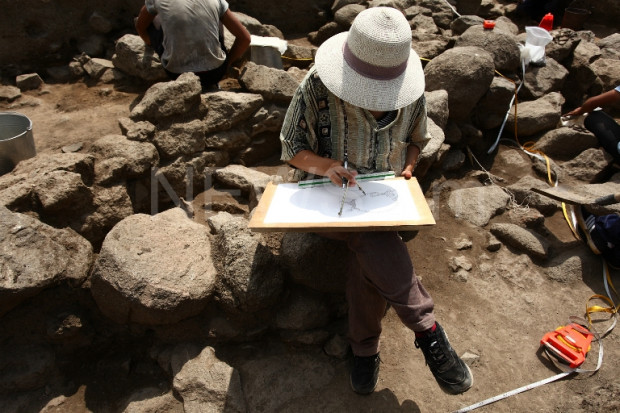Everything has been preserved here as it used to be 5,000 years ago—the hearth and the kitchen utensils round it. In archaeology, this is called an in situ condition.
Fire broke out here several times, but the reasons are unknown: it is hard to say whether the settlement was burnt by enemies or it was a household fire. Nevertheless, the traces of fire and several archaeological layers indicate that the life boiled in this place for several millennia.
Gegharot—this is the name of the archaeological monument located on a hill near the same name village in Armenia’s Aragatsotn Province. Leader of the Armenian-American expedition, archaeologist Ruben Badalyan told Armenian News – NEWS.am that 20 years ago Aragats project was initiated, within the framework of which not only excavations are conducted, but also comprehensive exploration of all the neighboring location is carried out from Tsaghkahovit valley and Kasakh riverbed till Aparan plateau.
This year archaeologists are studying two constructions in Gegharot. One of them is supposedly a residential house dating from the 3rd millennia B.C. A more precise description will be available after a through study of the entire material collected from here.
“This is a round stone construction with a 7 meter diameter, which is typical of Kur-Araks culture. We have several stages of housing development in this place. The archaeologists are now clearing the upper layer, but there are older constructions under it, which belong to the same culture,” Badalyan says.
The second construction, where the expedition is currently working, is in the far corner of the settlement. According to the archaeologists, a necropolis was located along the edge of the hill. “In the course of the excavations two years ago a unique, one-of-a-kind and— from archaeological viewpoint— a hard-to-read complex was revealed. It has a sustaining wall, the need wherein is dictated by the slope. Enormous engineering work was carried out by our ancestors,” the archaeologist stresses.
.JPG)
Behind the wall there is an open-air territory, whose plan resembles that of an apse. There are three tombs in it. No household items, labor tools or remnants of human activity were found here. The archaeologists think this territory might have a ritualistic significance, being linked with the burial ceremony.
The hill on which Gegharot monuments is located is 7 ha. Over 20 years of excavations, nearly 3,000 square meters have been explored. “This is a small part of the monument in terms of area but we don’t know whether the slope was entirely overbuilt or there were separate hearths. Nevertheless, if in the course of 20 years we explored only 3,000 square meters, there will be enough work here for several more generations,” Badalyan says.
The conducted explorations showed that this territory was first settled in late 4th and early 3rd millennia. Then there was a break, whose reason nobody knows, following which Gegharot was re-settled in the following 100-150 years. Afterwards, a longer break followed, and the traces of life were again found here already in the late Bronze Age, since the 2nd millennium till A.D. Not only Gagharot hill was then settled, but also the adjacent hills. And before the beginning of the first millennium, that is during 5-6 centuries, the life was very active here, the Cyclopean fortress on the hilltop and watchtowers on adjacent altitudes being indicative of this. “Gegharot—located on Pambak mountain range—had a strategic significance then: it controlled the trade of metal with “compatriots” from Lori,” the archaeologist says.
The specialists have no idea why the population left this place. No traces of destruction have been found here. There is every indication that people moved from this place to the south. Everything not presented in Gegharot can already be found in Aparan fortress, which is currently also studied by the archaeologists.
.JPG)
.JPG)
.JPG)
.JPG)
.JPG)

.JPG)
.JPG)
.JPG)
.JPG)
.JPG)






















